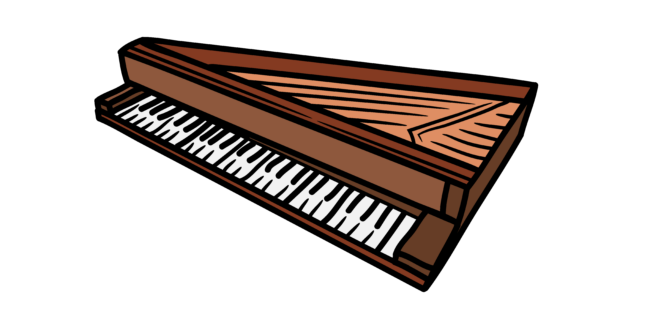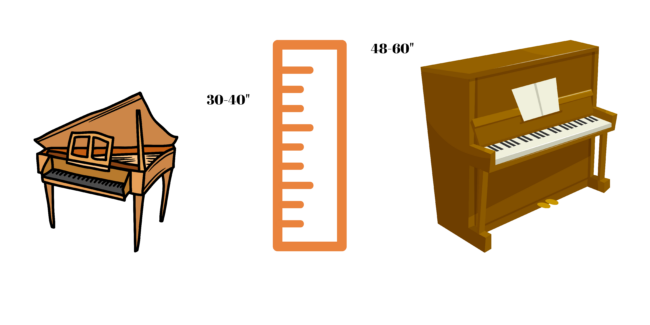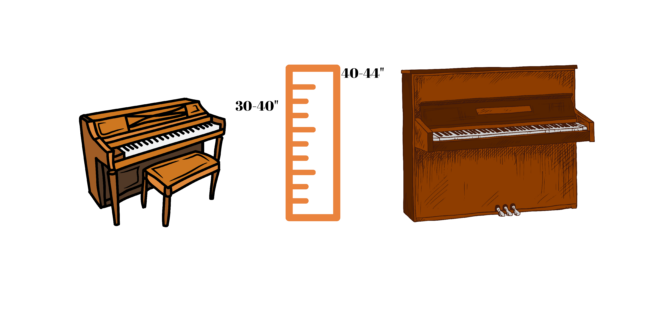What You Should Know Before You Buy a Spinet Piano

Do you know the difference between a spinet and an upright piano? Learn everything you need to know before buying a spinet piano.
A spinet is a close cousin to an upright piano. (At least it looks that way from the outside.)
The dainty size and natural wood consoles are eye-catching, but that’s not all: it comes with an attractive price tag.
Are they a good choice for a beginner piano student? We’ll show you how to tell if a piano is a spinet or an upright, how each model operates, and whether or not you should buy one.
What is a spinet piano?
A spinet is a smaller version of a piano and harpsichord. Its compact design stands only 30 to 40 inches tall. You may see an upright spinet, or it may have a wing-shaped look.

Although the spinet went out of production (and style) in the 1990s, you can still find these small-scale stringed instruments among second-hand dealers and private sellers. So what are the benefits of a spinet? And does the price match the value?
Advantages and disadvantages
Spinets are cute instruments and often have natural wood casings. They are cheaper than upright pianos and take up less space in your home. Many beginning piano players choose a spinet for a small living space or apartment life.
However, the compact size also inhibits the sound of the spinet. The small soundboard and cramped conditions of the spinet can make it sound tinny. Also, repairs can be difficult and costly.
What is the history of the Spinet piano?

Most experts trace the spinet’s history back to the 1500s in Italy. These first spinets were most likely wing-shaped and similar in design to harpsichords. However, the compact spinet was a welcome substitute for the bulkier and more expensive harpsichords. It became a popular instrument and made its way to England and other countries during the 1600 and 1700s.
In the 1930s, the upright spinet was a welcome edition in many American homes. These space-savers could fit easily into almost any house.
Spinets were produced until the 1990s, when manufacturers discontinued this model for its impractical design. Many brand names began to focus instead on consoles and pianos to offer customers superior sound quality.
Spinet vs. Upright piano
The spinet piano is often confused with an upright piano. Both pianos are often upright, stringed instruments with natural wood consoles. But while they might look the same on the outside, what’s on the inside counts.

If you look inside a spinet, the hammers are usually located below the key level, while on an upright, they are above. A spinet’s keys and hammers have a drop-action (also called indirect blow action). This is not nearly as effective as the key action on an upright piano.
With stringed instruments, size does matter. The spinet is too cramped to produce a quality sound. In contrast, the extra height of an upright piano allows for a larger soundboard and longer strings. This extra attention to the inside of the upright gives it a fuller sound.
Spinet vs. Console piano
Console pianos are between spinets and uprights when it comes to size. The console usually measures between 40 and 44 inches tall. However, it is closer to an upright piano than a spinet. Like an upright piano, the hammers are above the keys instead of below them on the console. Manufacturers are continuing to improve the design of the console piano. This popular instrument is not quite as compact as the spinet, but the console piano has a better sound quality overall.

Things to consider before buying a spinet piano.
Many argue that there are better options than a spinet piano for beginning students. But, if you see an ad for a spinet piano in your area for a reasonable price. It doesn’t cost anything (except gas money) to take a look. But before you buy, here are some things to consider:
Measure its dimensions.
If a piano is less than 40 inches tall, it can classify as a spinet. Most spinets are four to five feet long. Spinets also weigh about 200-300 pounds. Although not lightweight, it is possible to move a spinet from one room to another with someone to help you.
Count the cost.
Since production stopped on most spinets in the 1990s, you face a second-hand market when you buy one. Prices vary widely, but most spinets sell for under $1,500. It’s a reasonable price compared to upright pianos that sell for $10,000. If you find the right seller, you might walk away with a spinet for a bargain.
If you find a good deal on a spinet, keep in mind that you can spend $300 or more just to move the piano locally.
Test it out.
Spinets are generally more sensitive to wear and tear than an upright piano. Any spinet on today’s market is likely 30 years old or more. Besides the usual problems with sound, the age of this instrument can add extra complications. It is unwise to buy a spinet piano sight unseen. You want to meet your prospective instrument first.
Make sure all keys are in working order, have a good sound, and are stable without cracks in the console. Qualified piano technicians can also guide you when buying a piano or spinet. They can evaluate you accurately and clue you into potential repair costs.
Check the brand.
You also want to consider the brand name of the spinet. The Wurlitzer spinet is known for its durability. The Baldwin Acrosonic spinet had more success with its drop action hammers than many spinet models. Also, a 1970-era Yamaha is one of the better instruments in its category. These brands might be some of the better options when you look at a spinet. But, in the end, all brands decided to throw in the towel and quit spinet production entirely.
How should you move a spinet piano?
You find a spinet piano in good condition, at the right price, and not too far away. But, how do you bring it home?
Unlike a keyboard, you can’t just pack it up, carry it under your arm, and drop it in your trunk. You need to consider transportation that will keep it safe on its way to your home. Here are some tips for moving a spinet piano:
Cover the keys and pedals.
Use moving pads or blankets to cover the keys and pedals of your spinet. You want to secure this protective padding with belts or packing tape. The top, front, back, and sides should all be protected and padded before you load the spinet in the truck.
Use a piano board.
A piano board can help you move spinets and upright pianos. This board should be placed against the back of the spinet when you move it with a dolly. It ensures that your spinet is protected and the weight is balanced as you move it from place to place.
Load it properly.
Never lay a spinet or piano on its side when moving. It can cause damage to the instrument (and also takes up more space in your truck. When loading a spinet, place it against the back of the moving van. This gives the instrument stability and frees up space for other items if you move several pieces of furniture. You can tie down the spinet with an E-track belt or locking belt.
Measure twice.
Before you unload the spinet at its destination, you want to make sure you have accurate measurements. Measure the spinet (after it’s wrapped up and padded) and the doorways in your house. Then, you know where the spinet fits in your home and the best route to take to get it there.
Spinets are compact pianos that can easily fit into a home and add a touch of class to the room. However, when compared to other pianos, the sound quality falls short.
Most pianists recommend a digital piano instead of a spinet when beginners learn to play piano. A digital piano has weighted-key action that is similar to an acoustic piano. They are usually in the same price range as a spinet and are more satisfying to play.









